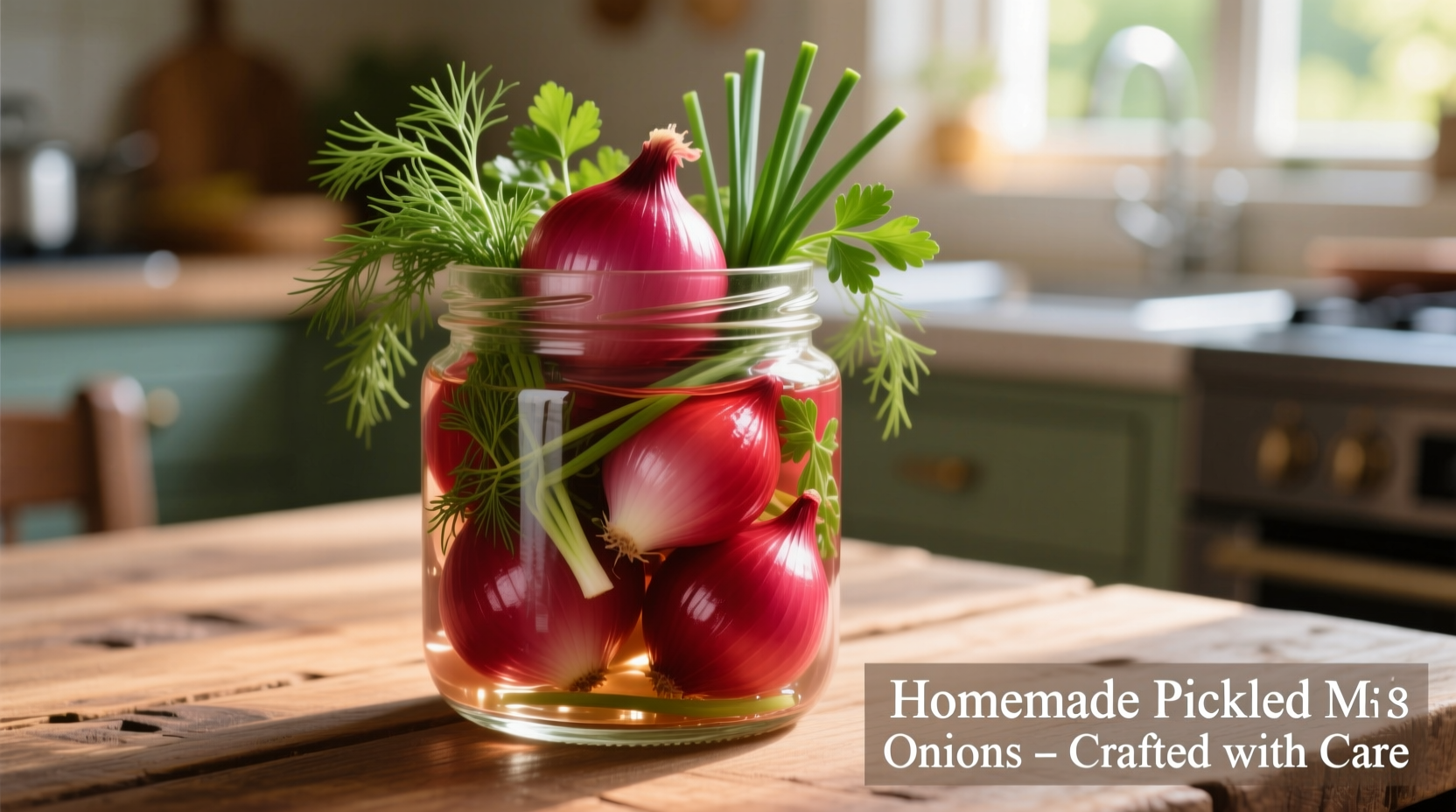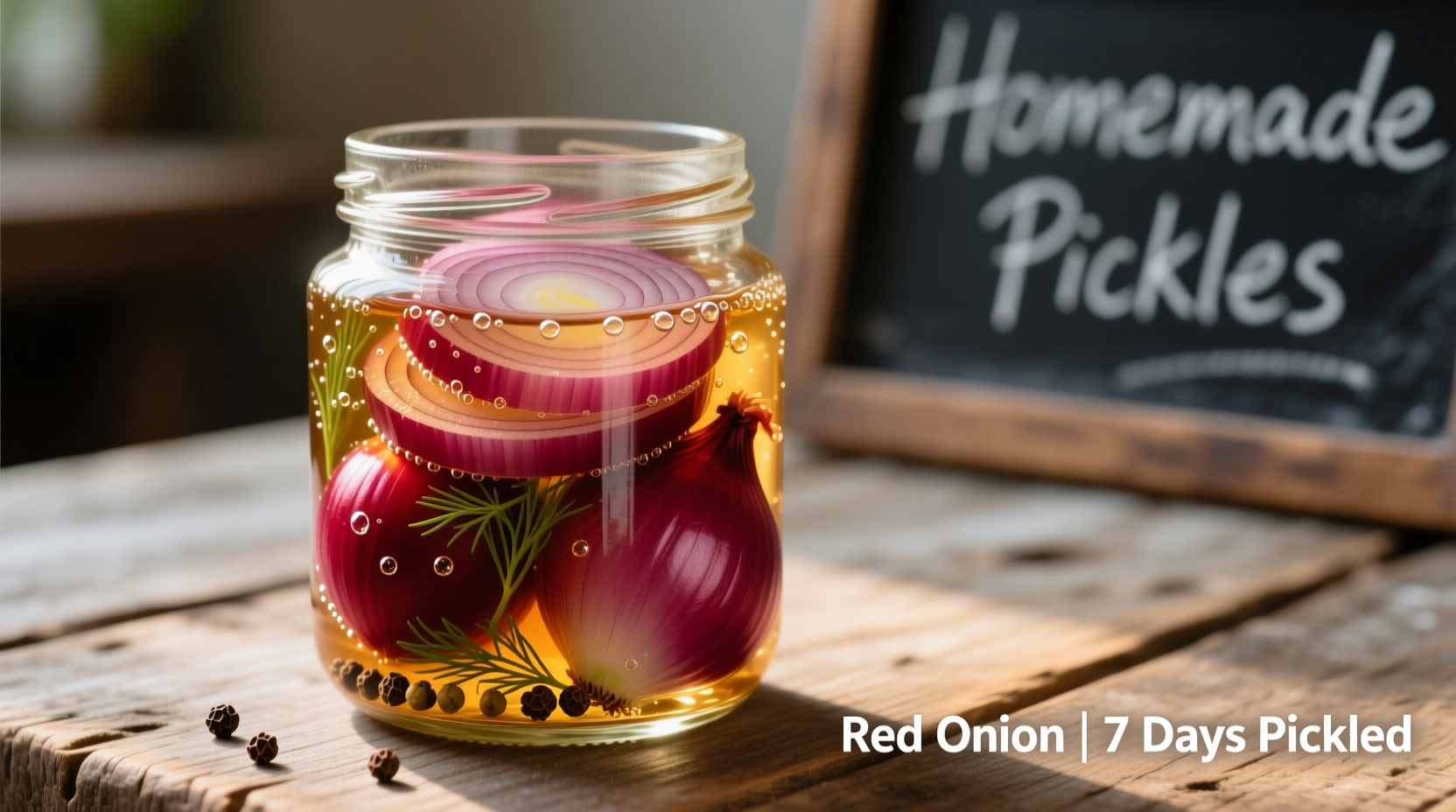Discover why chefs reach for pickled red onions to add instant sophistication to everyday dishes. These ruby-hued slices deliver the perfect counterpoint to rich proteins and fatty ingredients, cutting through heaviness while adding visual appeal. Unlike store-bought versions filled with preservatives, homemade pickled red onions offer superior flavor control and freshness.
The Science Behind Perfect Pickled Red Onions
Understanding the chemistry transforms your results from hit-or-miss to consistently excellent. When onions meet vinegar's acidity (typically 5% acetic acid), a remarkable transformation occurs. The acid penetrates the onion cells, breaking down harsh sulfur compounds while preserving the vibrant anthocyanins that give red onions their signature color.
| Pickling Agent | pH Level | Flavor Profile | Best For |
|---|---|---|---|
| Distilled White Vinegar | 2.4-3.4 | Sharp, clean | Classic applications, bright color retention |
| Apple Cider Vinegar | 3.0-5.0 | Fruity, mellow | BBQ dishes, fall-inspired recipes |
| Rice Vinegar | 3.0-4.0 | Delicate, slightly sweet | Asian fusion, delicate salads |
According to USDA Complete Guide to Home Canning, maintaining proper acidity (pH below 4.6) prevents harmful bacterial growth during the pickling process. This scientific approach ensures both safety and optimal flavor development.
Master the Basic Technique in 4 Simple Steps
Professional results require no special equipment—just attention to timing and ratios. Follow this foolproof method for consistently crisp, flavorful pickled red onions:
- Prepare onions: Thinly slice 2 medium red onions (1/8 inch thick) using a mandoline or sharp knife. Separate into rings.
- Create brine: Combine 1 cup vinegar, 1 cup water, 2 tablespoons sugar, and 1 tablespoon salt in a saucepan. Optional: Add 1 teaspoon whole peppercorns or 1 dried chili.
- Heat and cool: Bring brine to simmer (do not boil), then pour over onions in a heatproof container. Cool to room temperature.
- Refrigerate: Cover and refrigerate for at least 30 minutes before serving. Flavor improves over 24-48 hours.

Troubleshooting Common Issues
Even experienced cooks encounter these challenges. Here's how to solve them:
- Mushy onions: Overexposure to heat damages cell structure. Never pour boiling brine directly onto onions—simmer brine first, then cool slightly before pouring.
- Dull color: Acidic environments preserve anthocyanins, but prolonged exposure to heat causes fading. Use room temperature or warm (not hot) brine for brightest results.
- Excessive sharpness: Reduce vinegar-to-water ratio to 1:1.5 or add 1/2 teaspoon baking soda to neutralize excess acidity without compromising safety.
Flavor Variations for Every Cuisine
Elevate your pickled onions with these chef-approved adaptations:
- Mexican Style: Add 1 sliced jalapeño and 1 teaspoon cumin seeds to brine. Perfect for tacos and quesadillas.
- Mediterranean Twist: Include 2 smashed garlic cloves and fresh oregano sprigs. Ideal with grilled lamb or feta salads.
- Asian Fusion: Substitute rice vinegar, add 1 star anise and 1-inch ginger slice. Complements sushi bowls and bao buns.
Food science research from the Journal of Food Science confirms that adding aromatic spices during the pickling process allows flavor compounds to bind with the vinegar's acetic acid, creating more complex and stable flavor profiles than post-pickling additions.
Storage Guidelines and Shelf Life
Proper storage maintains both safety and quality:
- Always use sterilized glass containers with airtight lids
- Refrigerate below 40°F (4°C) immediately after preparation
- Consume within 3-4 weeks for optimal flavor and texture
- Never introduce utensils directly into the container—use clean tongs
The National Center for Home Food Preservation confirms that properly acidified pickled vegetables remain safe for consumption for up to 4 weeks when continuously refrigerated. Discard if you notice cloudiness, mold, or off odors.
Culinary Applications That Impress
Move beyond basic tacos with these professional applications:
- Breakfast boost: Top avocado toast or scrambled eggs for acidity that cuts through richness
- Cheese board essential: Pair with sharp cheddar or creamy goat cheese to balance fat content
- Salad revolution: Toss with bitter greens like arugula to create balanced vinaigrette effect
- Meat accompaniment: Serve alongside grilled steak or pork to cut through fatty flavors
Chef Thomas Keller's Ad Hoc at Home demonstrates how pickled onions transform simple sandwiches into restaurant-quality experiences through strategic acid balance—a technique now accessible to home cooks.
Frequently Asked Questions
How long do homemade pickled red onions last in the refrigerator?
Properly stored in a sterilized glass container with a tight-fitting lid, homemade pickled red onions maintain optimal quality for 3-4 weeks when continuously refrigerated below 40°F (4°C). The USDA recommends discarding any pickled vegetables showing signs of mold, cloudiness, or off odors.
Can I use different types of vinegar for pickling red onions?
Yes, but maintain proper acidity levels. Distilled white vinegar (5% acidity) creates the brightest color and sharpest flavor. Apple cider vinegar offers fruitier notes while maintaining safety. Never use homemade vinegar or vinegar below 5% acidity, as this compromises food safety. The National Center for Home Food Preservation requires minimum 5% acidity for safe refrigerator pickling.
Why do my pickled red onions turn blue or green?
This harmless color change occurs when anthocyanins in red onions react with metal ions, often from aluminum pots or copper utensils. Use non-reactive containers like glass, ceramic, or stainless steel. The color shift doesn't affect safety or flavor, though it may appear less visually appealing. According to the Journal of Agricultural and Food Chemistry, this reaction is purely cosmetic and doesn't indicate spoilage.
Do pickled red onions retain nutritional benefits of fresh onions?
Yes, though some water-soluble vitamins decrease during pickling. The fermentation process creates beneficial compounds while preserving quercetin, a powerful antioxidant abundant in red onions. Research published in the Journal of Food Science shows that pickling actually increases bioavailability of certain antioxidants while adding probiotic benefits from the vinegar's acetic acid.











 浙公网安备
33010002000092号
浙公网安备
33010002000092号 浙B2-20120091-4
浙B2-20120091-4